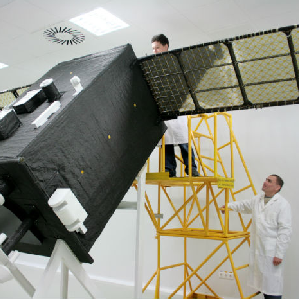
English > News
The first launch from the space launcher complex Vostochniy will start the new near-Earth researches
30.03.2016, 10:32
In the spring of this year the scientists of Samara State Aerospace University (SSAU) will proceed to integrated exploration environment in the near-Earth space and its impact on the engineered materials of spacecraft.
The spacecraft “Aist-2D” made by SSAU scientists and specialists of the Rocket and Space Centre “Progress” will become the research basis. This spring it will be launched into space by the first carrier rocket from the new Russian space launcher complex Vostochniy.
A set of scientific equipment was installed on the satellite board. The scientists are going to use it in exploring parameters of the natural and external atmosphere (gas environment) of a spacecraft and external factors of the space environment that affect the device construction materials, on-board equipment, have impact on the course and results of the various technological experiments conducted on the spacecraft board. The set includes three instruments: mass spectrometry sensor DMS-01, “solar wind” sensor and gamma counter. The equipment set is designed and manufactured in SSAU Institute of Space Device Engineering (ISDE).
“At the beginning we'll have a very intensive gas release from the satellite structures, because it consists of a large number of organic materials. After 2-3 weeks the unit will be almost dis-inflated and we’ll be able to evaluate the levels of atomic oxygen, which is the most powerful oxidant. Within 3-4 months we’ll begin to measure the impact of solar activity and radiation levels on the unit”, - told Igor Piyakov, Candidate of Technical Sciences, senior research fellow of SSAU Institute of Space Device Engineering, describing the experimental sequence.
During the day, the sensor DMS-01 will perform eight measurements in fours 10-minute measurements at two passes. Ten spectrums with 1 minute sampling rate will be determined by each measurement. The most specific characteristics of the four device location in orbit will be measured: on sunny side, on high sun and when the unit is most heated; at the lowest temperatures on the dark side; at sunrise and at sunset.
The information obtained in the course of these studies will allow SSAU scientists to build a model of external effects of the space environment on a small unpressurized spacecraft, namely “Aist-2D”, and further reproduce this model on the Earth, in the University laboratories. It will significantly reduce the cost of making and testing of new materials for spacecraft production. For this purpose, SSAU Institute of Space Device Engineering is building the second laboratory bench of space environment factors simulation (vacuum chamber with a particle accelerator), which allows, for example, to disperse the microparticles to speeds of 15 km per second.









